► Living with a DS 7 Crossback
► Just what exactly is it?
► Colin is trying to find out
Month 7 living with a DS 7 Crossback: DS immersion
I’d approached the day wearing a sandwich board proclaiming ‘We’re All Doomed (But Particularly DS)’ yet ended it like John Belushi somersaulting down the church aisle in The Blues Brothers.
I’d half-expected that at some point during my four hours immersed in the DS Automobiles universe, the DS personnel would stop mid-sentence, slap their foreheads and proclaim: ‘Oh my days! You’re right. You’re so, so right. This is clearly a ludicrous idea and it will never work.’
But no. Because they’re convinced it will work. It is working. And their belief is infectious, their arguments convincing.
The challenge is making a success of a new car maker, DS Automobiles, a standalone brand within the PSA family since 2015, having previously been a Citroën sub-brand. They haven’t made it easy for themselves. They’ve cut the range down to three cars at the moment – the DS 7 Crossback, launched last year, the DS 3 Crossback, which joined it this year, and the departing DS 3. The range is being purged of everything that has a Citroën twin, and will slowly work its way up to being six strong, with electric and hybrid variants, and soon a non-SUV.
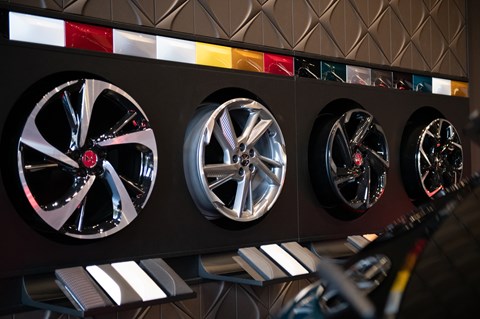
And what used to be a massive dealership network, with a DS section in a larger Citroën showroom, has been pared back to a tiny (but growing) number of DS Salons and DS Stores.
Brave! Visionary! Pioneering! Or reckless, unrealistic, impractical. Alain Descat, managing director of DS in the UK, pulls no punches: ‘In the first half of 2018, UK sales were around 4000 cars. In the second half [when the range and the network had both undergone a drastic pruning], UK sales 1000. We had to take the pain, but it’s worth it.’
DS is acting like a start-up and selling cars in a new way. Descat’s point is that cars are being bought and sold (and leased and hired) in a new way anyway, so better to be on the front foot, creating a range that’s suited to the times and a dealer network suited to the range.
Descat is talking me through the thinking while we munch sandwiches in a meeting room above the DS Store Birmingham North. DS Stores are the bigger, fancier showrooms; DS Salons are smaller. ‘Globally, at the end of 2017 we had 229 Stores and Salons. By the end of 2021 that should be 750,’ he says. ‘It was 18 in February last year and there are 35 in the UK today. We’re not covering the full country. But we’ll soon be up to 60.’
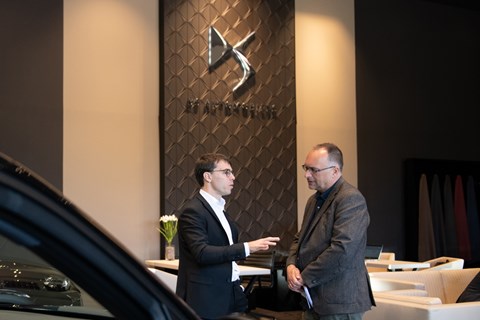
Earlier, I’d visited the DS Salon in Stafford. It’s unlike other car dealerships, but relatively normal compared to a Store. Paul Irving, ‘DS Expert Advisor’ (they don’t call themselves salesmen) at Stafford, explains that in this online age customers are now generally very well informed before they visit or contact the dealer, and often know exactly what they want. His job is not to charm or persuade, but to make it easy for them to have an extended test drive, to get answers to their questions, to talk about the many perks of DS ownership.
Some customers are long-time French-car buyers, some are DS fans who’ve gone 3, 4, 5 and now 7 – ‘and some the other way too, from larger to smaller: a premium feel in a size that suits them better’.
The Salon where I meet Paul and general manager Craig Norton is smart, modern and very different from neighbouring old-school dealerships. But an hour down the M6, at the DS Store Birmingham North, is where the DS experience can be seen in full bloom. The extra space is used to provide an even more relaxed, feng shui kind of environment, not to cram in more cars. There are 7s and 3s, of course, but also artfully textured walls, modernist furniture and glass coffee tables of a kind you get in fancy hotel lobbies. The soundtrack and the perfume in the air are not left to chance.
Anathema, you might think, to someone with a solid grounding in the old way of selling cars. But no. Richard Garbutt, sales director of Robins and Day, the dealer group that controls Birmingham North, says: ‘There’s an excitement running through the network. It’s a real transition in the industry. I’ve been with the group for 25 years. It’s the best it’s ever been.’
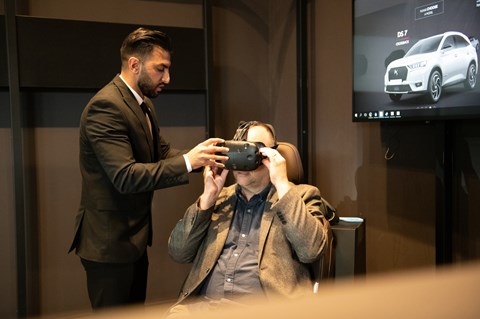
The Birmingham Store has a virtual-reality configurator. There’s no way any dealership would be big enough to house every option of paint, wheel and upholstery, and with VR there’s no need. You get to look around the inside and outside in brilliant detail, changing any detail you like. And there’s a salesm… sorry, DS Expert Advisor by your side to suggest fresh combinations.
One of the many things that had been confusing me about DS was the fact that the manufacturer was Formula E world champion, but not making a huge fuss about it. Certainly my petrol-fuelled four-cylinder DS 7 Crossback is, beneath all its glitz, a pretty conventional car, with zero connection to Formula E. But that, I’m assured, is all about to change. As the range expands, hybrids and electric DSs will become the norm.
When electrified DSs are on the road, Formula E will become much more prominent in DS’s marketing. Descat notes: ‘Customers are not very loyal when they go electric. As the new kid on the block, that’s an opportunity.
‘Winning Formula E is perfect timing. You need proof. DS has built the best car in Formula E, with the best algorithms. We learn a lot from Formula E.’
The perfectly decent petrol engine does not define my DS 7, and I suspect the imminent hybrid version will similarly be all about the styling, the ambience and the interior, not about the powertrain.
Heading home down the M6 and M1, I’m newly enthused by the idea of DS. What had seemed like a ludicrous self-imposed burden – hardly any cars! hardly any dealers! – now looks like a smart bit of getting in ahead of the herd with new ways of engaging with customers and new ways of making cars enjoyable.
That said, much of what’s impressed me about the 7 has been nothing to do with customer engagement and everything to do with older virtues: it’s a car that’s comfortable, roomy, calming, safe and well built, and rare enough to always be a talking point.
By Colin Overland
Logbook: DS 7 Crossback Prestige PureTech 225
Price £39,530 (£40,280 as tested)
Performance 1598cc 4-cyl turbo petrol, 221bhp, 8.3sec 0-62mph, 141mph
Efficiency 36.5mpg (official), 35.8mpg (tested), 136g/km C02
Energy cost 16.1p per mile
Miles this month 2134
Total miles 20209
Month 6 living with a DS 7 Crossback: F1 mega-trip!
I used to daydream about this, a lot. It was triggered by my weekly conversations with Denis Jenkinson, the legendary motor racing writer. As one of my first jobs as an F1 writer, and one of his last, I’d phone him for his input into previews of each race in the 1995 F1 season. But only a tiny part of each conversation was spent discussing whether Damon Hill could stop Michael Schumacher from winning. The bulk of our chats revolved around Jenks’s life in the ’50s – and what a life.
As the Continental correspondent of Motor Sport, he used to leave England in March and only return home after the season had ended. He drove from race to race in his E-Type Jag and sent his reports by post. He would go on holiday with the drivers, and he loved the south of France.
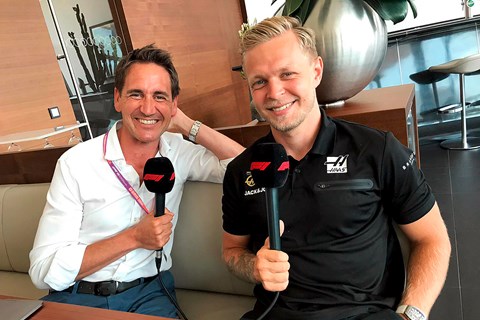
Those conversations left their mark on this impressionable 20-something, and I’ve wanted to ‘do a Jenks’ ever since. By that I mean go nomadic: drive across Europe and live out of the boot of my car. And it finally happened this summer. There was no E-Type, but there were two F1 races – France and Austria, on consecutive weekends – and plenty of racing drivers involved. Logistics at Paul Ricard and the Red Bull Ring are a pain. The nearest international airports are many miles away – 140 miles in the case of the Red Bull Ring – so driving feels like a sensible thing to do – and that’s where CAR’s DS 7 Crossback comes in. I’d never previously driven an SUV or a DS, but I needn’t have worried: it’s classy and comfortable, yet lively enough to keep up with Ferrari star Charles Leclerc while driving from Monaco to Paul Ricard.
On the Monday before the French GP I headed from Calais to Dijon and only after I’d reminisced about Gilles Villeneuve and Rene Arnoux’s titanic scrap for second place there in the 1979 French Grand Prix did I continue my journey south to Monaco for a catch-up with Leclerc. We then drove in convoy – Leclerc in a Ferrari GTC4 Lusso – for the final 120 miles to Paul Ricard. He got a bit of distance away from each peage, but otherwise it was even-stevens.
We stopped at the Brignoles kart track, where Charles started his racing career 15 years ago. The place hadn’t changed and nor had its raison d’être because, coincidentally, Felipe Massa was there giving his eight-year-old son Felipe his first test in a kart.
It was then on to Paul Ricard. While it might have been a shockingly dull race, there was a fantastic turn-out of French racing drivers. One highlight was sitting down with ’80s Ferrari ace Patrick Tambay, who now suffers from Parkinson’s disease, for an emotional chat about Villeneuve.
But it was in the days between France and Austria that the DS 7 afforded me the greatest luxury of all: time. With no airport departure boards blinking at me, I could ease my way towards the Austrian Grand Prix, via a small hotel on the eastern side of Nice – an area often frequented by Jenks. There was a bike hire shop nearby, prompting two days of two-wheeled adventure, cycling to Monaco and La Turbie on consecutive mornings.
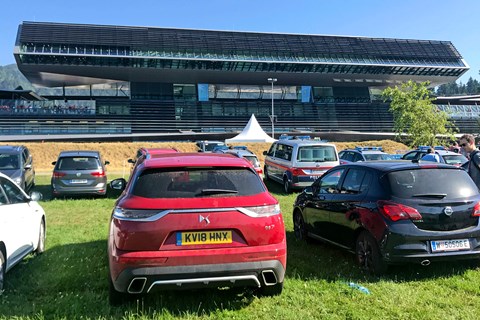
The 600-mile drive to Zeltweg had to be done in one hit on the Wednesday. Follow the coast to Genoa, then head north-east to Venice, before the final push through the Alps to the Red Bull Ring. The F1 trucks had made the journey three days earlier, double-shifting with two drivers; I meandered my way through some stunning scenery.
After 10 hours of driving in 34º heat I arrived at my gasthaus. It’s where the management of Stewart Grand Prix used to stay and the hotel owner took great delight in telling me Princess Anne had been a guest of the team one year and had stayed in my room. Yes, I’ve shared a bed with Princess Anne. I’d arranged to meet six-time Le Mans winner Jacky Ickx at his home in Brussels the day after the race. To make it in time, I left straight after the chequered flag and drove 370 miles to Wurzburg, before then completing the final 360 miles to Brussels on Monday morning.
Jacky Ickx? Total legend. And humble too: ‘I sometimes wonder why I survived and others didn’t.’
With that interview done, it was time for the final push home. After 3200 miles of motoring, split over two weeks, I arrived home feeling surprisingly fresh. It had been a life-enhancing trip, and it’s all thanks Jenks – with a little help from DS.
By Tom Clarkson
Logbook: DS 7 Crossback Prestige PureTech 225
Price £39,530 (£40,280 as tested)
Performance 1598cc 4-cyl turbo petrol, 221bhp, 8.3sec 0-62mph, 141mph
Efficiency 36.5mpg (official), 32.8mpg (tested), 136g/km C02
Energy cost 18.2p per mile
Miles this month 3128
Total miles 18075
Month 5 living with a DS 7 Crossback: two breakfasts!
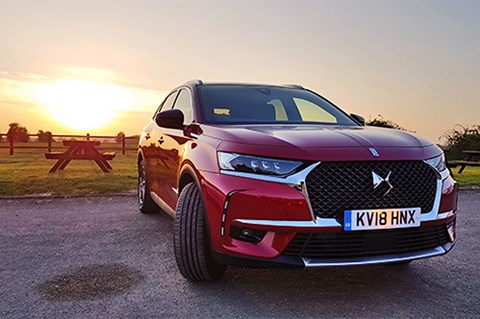
Booty call
Even the most selfish day out must involve some multi-tasking, so my drive from Northampton to Stafford to look at old motorbikes starts with a minor detour to a recycling bank. The DS 7’s boot isn’t huge, but big enough to get rid of a wardrobe full of old clothes.
Not just transport
A bit of local knowledge comes in handy – I know the A5199 will be quiet, giving the big DS the chance to engage with a few bends in its smooth, soft way. This heavy, front-wheel-drive crossover is nobody’s idea of a country-road scorcher, but those bends help make the journey less of a slog.
Second breakfast o’clock
Slow going on the M6 brings the chance to optimise the instruments, and finally get them showing what I want. The lure of Greggs at Hilton Park Services proves impossible to resist. Love the architecture, although it could do with a lick of paint. Today’s reassuring stodge takes the form of a nacho chili cheese bake.
And then there were two
Time to find a mate who’s travelling to Stafford by train. We’ve agree to meet not at the station but at the nearest pub, so he has somewhere dry and comfortable to wait, and I don’t have to battle the congestion of the short-stay car park. The sat-nav excels here.
Mon frere!
At the Stafford Showground, as luck would have it, I park the DS next to another French oddity, the fantastically unpopular Renault Avantime (the three-door luxo-coupe MPV from the early noughties, and not to be confused with the marginally better selling Vel Satis, the luxo saloon).
Thirsty work
The journey home involves heading east to Derby, pausing for refreshment near Shardlow, then down the M1. It’s smoother than the drive up, but the morning’s stop-start traffic had done its damage to the day’s economy: low 30s.
By Colin Overland
Logbook: DS 7 Crossback Prestige PureTech 225
Price £39,530 (£40,280 as tested)
Performance 1598cc 4-cyl turbo petrol, 221bhp, 8.3sec 0-62mph, 141mph
Efficiency 36.5mpg (official), 32.8mpg (tested), 136g/km C02
Energy cost 18.2p per mile
Miles this month 1318
Total miles 14947
Month 4 of our DS 7 Crossback long-term test: bring on the jams
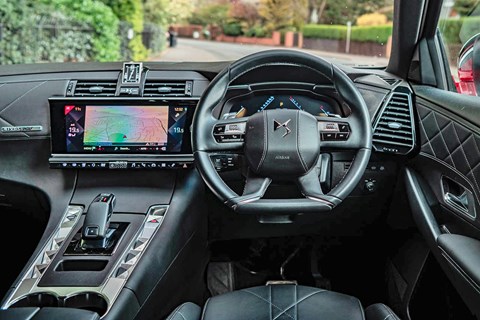
Here’s something that’s new to me: rugby being played in blazing sunshine. Here’s something not so new: the traffic in the Twickenham area being incredibly, ridiculously heavy (not least because in the same area you also have Kew Gardens and the Oval cricket ground). In fact the whole journey down the M1 and round the North and South Circulars was horrendously busy. But the DS 7 Crossback was superb. The climate control worked a treat, the leather seats stayed comfortable, the tinted rear windows made a difference, the sound-deadening kept the outside world at bay and the audio system (which links very readily to phones and other devices via Bluetooth if you can’t face doing battle with the inaccessible USB slot) kept us entertained. It’s no dynamic hot-shoe, but the DS is brilliant in a traffic jam.
The interior was also very much the focus when I had a couple of days in a different version of the DS 7, a diesel in Ultra Prestige spec, with Opera cabin trim, in a shade of gold well suited to the car’s curves.
The engine was the more powerful of the two turbodiesels, the Blue 180, making less power but more torque than my red petrol. Its claimed combined fuel consumption of 42.7mpg is easy to achieve. That’s got to be down to the fact that this is a car that’s happiest being driven slowly. Try to hurry it and it gets harsh and clunky, so you ease off. My petrol DS is also a car that you don’t push hard, but that’s more a case of it rewarding smooth driving, whereas the diesel discourages rapid driving.
So I’m reassured that I already have the best engine. But there were several other differences between the cars where I’d vote gold rather than red. The sunroof, for instance, the absence of which makes my car seem a bit gloomy. And the electronic boot opening and closing mechanism, which means no more sprained wrists on the awkwardly angled handle. And the heated seat control has moved: rather than my knurled dial awkwardly placed in the phone charging area, this is built into the touchscreen, just under the main temperature control. The package also includes DS Connected Pilot, which brings lane keeping assist and active cruise control, an audio upgrade, 20-inch wheels and nappa leather in the cabin.
But there’s a price to pay: £45,485, about five grand more than mine. My engine in this trim would be £140 cheaper than the diesel. Either way the sums involved are on the high side.
By Colin Overland
Logbook: DS 7 Crossback Prestige PureTech 225
Price £39,530 (£40,280 as tested)
Performance 1598cc 4-cyl turbo petrol, 221bhp, 8.3sec 0-62mph, 141mph
Efficiency 36.5mpg (official), 31.2mpg (tested), 136g/km C02
Energy cost 18.2p per mile
Miles this month 1493
Total miles 13629
Month 3 driving a DS 7 Crossback: you drive our car
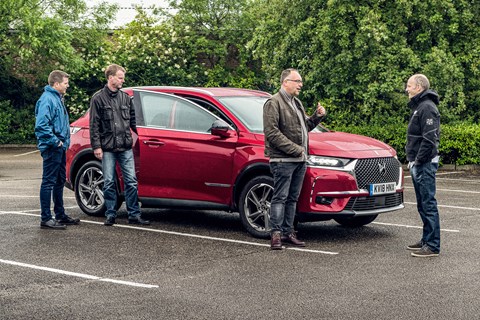
What’s that squelching sound? That’ll be the can of worms PSA opened when it resurrected the DS name, once the badge on a stylish, innovative, slightly peculiar Citroën made from 1955 to 1975. Used since 2010 as part of the model name for some of the quirkier Citroëns, it’s now a brand in its own right.
The first standalone DS, the 7 Crossback, here meets a reader panel that includes two people with original DS experience under their belts. Our mission: find if there’s a real link to DSs of yore, and how well it works as a modern crossover.
The creaking ruin
It’s all about comfort these days for CAR’s increasingly decrepit Colin Overland. He’s been won over by the cosseting Crossback but suspects our guests won’t see past the bling.
The potential buyer
Stuart Adam owns a Volvo XC60 and is gagging for a change. Will the DS be practical enough for his family and business needs?
The classic buff
Phil Bell is going to be hard to convince: he knows his DS heritage, and his taste in modern cars veers towards sporty coupes, not crossovers.
The eccentric
Hugo Wilson’s car ownership CV goes big on Citroën CXs and XMs; will the DS 7 recapture some of that lost quirkiness?
Phil Bell
Phil Bell is immersed in the world of authentic classic cars, and he’s not buying the notion that this is a continuation of the classic DS heritage. He’s driven a couple of originals, and for him the 7 Crossback is interesting not as a reincarnation of that heritage, but as a thoroughly modern car that could bring the reliability and convenience not always provided by older cars.
And, as he’s still recovering from a recently broken ankle, he’s particularly alert to the car’s ease of use, with its smooth petrol engine and eight-speed auto ‘box.
Phil, whose usual transport is a 2002 BMW 325 Ci Sport, says: ‘The original DS was the most advanced car of its time when it was launched. Sensational! I’ve driven two or three of them, and they more than lived up to expectations. The modern ones have a lot to live up to. The way they looked, comfort, design…
‘I must admit I smiled cynically when I heard it was being reintroduced as a brand. Modern DS is nothing like as radical. It’s trying to be distinctive in its feel, and anti-German in the way it rides so softly, bar the odd lateral lurch when it hits a bump. Inside it’s nicely trimmed and the metal details have a nice look and feel. DS could have gone further in being a bit more leftfield. It’s quite cautious. Some of the details aren’t so much stylish and classic as just chintzy.’
Driving it was a pleasant surprise. ‘It should feel different from my 3-series, and it does. That extra layer of softness is OK – you flow with it.
‘I thought it went very well for its weight. It’s a good size for people, if not for luggage – there it falls victim to the shape of the body. There’s plenty of room for two adults up front and two or three in the back, but you’d end up fitting a roofbox for their bags.’
Having to turn the over-harsh lane assist off every time you restart is annoying: ‘It’s a bit nannying.’
Phil sums up: ‘To drive, it’s very pleasant. It’s not the car for my tastes or needs, but I would recommend it to someone looking for a crossover. They should drive it. It’s a lot of money, though.’
Hugo Wilson
Hugo Wilson has no time for ordinary. He’s got form with quirky French cars, and indeed quirky cars in general, having also owned a couple of Fiat Multiplas and currently a Qubo. Does the DS 7 Crossback tickle his French fancy? Or does he see straight through the visual fripperies and just regard it as a big modern lump?
‘I ran Citroën CXs and then XMs for 15-20 years. You bought cheap at high miles and ran them until they broke. One CX was very good, but the other gave me endless grief. The XM was really nice, but after coming from the CX it didn’t feel so Citroëny. When the second XM had run its course I discovered that there were no longer weird Citroëns, so I switched to Multiplas.
‘I really like cars, but liking cars doesn’t mean you have to go down a fixed route, the performance route. I don’t need a car to be exciting – I get that from motorcycles – and I’m happy for it to be wafty. I want the interior to be fantastic. That doesn’t need to involve a ton of gadgets. The Multipla was a really good place to be, and the CX was great with its drum speedo and rocker switches – but everything was intuitive.
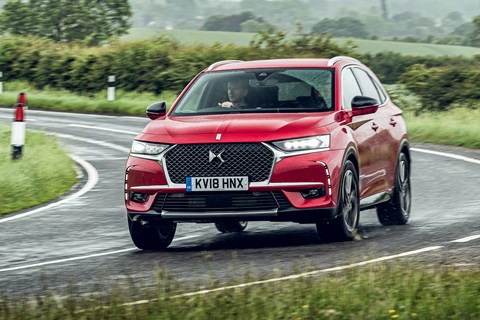
‘I’ve driven original DSs. I liked the way they were so swoopy, yet you sat high up, like you do in this. In this, though, there’s no logic to the design, and the interior space is bad for a car of this size. When you’ve driven Multiplas, with no central tunnel, you wonder what all this bulk by your left leg is for. This makes terrible use of space.
‘And it’s a DS in no sense. There’s an element of emperor’s new clothes about this. There’s no connection to the original DS. That said, although I’m disappointed by the weird mismatch between the hype and the reality, it works well.’
Stuart Adam
An eclectic history of car ownership – taking in three Vauxhall Astras, a Renault Megane RS, a VW Passat CC, a Mk1 Audi TT and much more besides – has led Stuart Adam to a Volvo XC60. And he hates it. He reckons it’s a ‘Friday afternoon’ dud.
‘It’s on its second clutch, the flywheel has been changed, the air conditioning has been out twice, the driver’s seat is loose. I’ve recently test driven the Nissan Qashqai and X-Trail, and I looked at a Discovery Sport but couldn’t get a deal. But the XC has been such a bad experience that it’s probably put me off soft-roaders. Now I really like the idea of a hybrid saloon. A used 530e plug-in hybrid tops my wish list. But then my wife would really like a used BMW i3. Cars matter to me, and I really worry that I’m going to make the wrong decision.’ So could the DS lure him back towards crossovers?
‘I like the Frenchness that they’re playing with, although I’m glad they’ve avoided the equivalent of the flags on the Mini’s tail lights. I’m not that bothered by the classic DS – I prefer modern cars, and here they’re clearly doing something very different and quite modern, with no nods to the old ones.
‘The interior stands out for me. It’s not as exciting outside, although there’s some theatre in the lights.’ The eye-catching interior has some issues, though. For instance, you can’t actually see the cruise control switches. ‘I guess that’s because they’re trying to keep the steering wheel clean, but it means you’re taking your eyes off the road. And the cubby in front of the gearlever is very fiddly, with a lid that wants to trap your fingers and a USB slot that needs a contortionist’s wrists to reach.
‘But I like the weight of the steering, and I like the ride. It feels softer than my Volvo, and yet it leans less through corners. The DS generally feels better set-up.
‘It’s a nice experience, with a few foibles. I could see myself in there.’
By Colin Overland
Logbook: DS 7 Crossback Prestige PureTech 225
Price £39,530 (£40,280 as tested)
Performance 1598cc 4-cyl turbo petrol, 221bhp, 8.3sec 0-62mph, 141mph
Efficiency 36.5mpg (official), 31.2mpg (tested), 136g/km C02
Energy cost 18.2p per mile
Miles this month 1062
Total miles 10659
Month 2 living with a DS 7 Crossback: Thames excursion
You know that thing people say about crossovers (as opposed to serious 4x4s), that the only time they go off-road is to mount a pavement outside a prep school? In the case of this particular crossover, it wasn’t quite a prep school, it was around the corner from a Harley-Davidson specialist in Southend, and I wasn’t trying to mount the pavement but park neatly next to it. But it didn’t go well.
I failed to notice how uneven the pavement was where I was about to open the driver’s door, and it scraped the black-plastic bottom section – barely visibly, but I know it’s there.
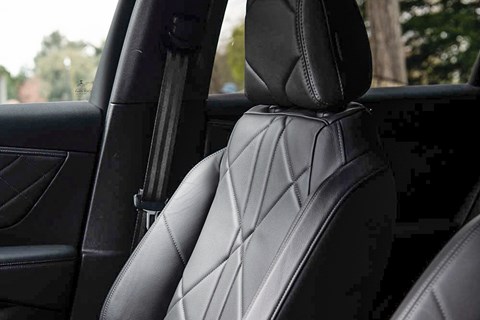
It’s a reminder, should one be needed, that the DS 7 is all about on-road comfort, at which it continues to excel. The excursion to the Thames estuary was part of a week of daytrips and parental chauffeuring, where the easy access, comfortable chairs, subdued ambience and refined ride all made friends. An old mate, who’s put his frenzied Renault 5 GT Turbo days behind him, had a good poke around and started considering one as the replacement for his Audi A4. Nobody’s terribly sure what it is, but to spend time with it is to like it. (The count of other DS 7s I’ve spotted since getting this one has, by the way, doubled to two.)
By Colin Overland
Logbook: DS 7 Crossback Prestige PureTech 225
Price £39,530 (£40,280 as tested)
Performance 1598cc 4-cyl turbo petrol, 221bhp, 8.3sec 0-62mph, 141mph
Efficiency 36.5mpg (official), 31.2mpg (tested), 136g/km C02
Energy cost 18.2p per mile
Miles this month 1062
Total miles 10659
Say hello to our DS 7 Crossback long-termer
It takes 28 days between this DS arriving at CAR and me seeing my first other DS 7 Crossback on the road. It’s quite a moment. I do a double take. My jaw drops a fraction. I very nearly wave. And I’m astounded by how huge it looks.
Now, finally, I understand why so many pedestrians and other drivers react so strongly to the sight of the French crossover. I had thought it was just confusion over the badge – a squiggle that says DS if you know it says DS, but even then still requires a high degree of swottiness to process and position correctly, like when you see a Honda wearing an Acura badge in the US. That’s not the main thing, though; the simple, now-obvious explanation is that it’s as visually arresting as a Bentley Bentayga or any big current Lexus.
The car-wash team that give it a thorough sprucing up, who see enough cars to get very blasé, are fascinated by the DS 7 – their first, it goes without saying. Seeing it through their eyes, the Crossback is rich in unusual details. Mine is in Prestige spec, which brings 19in grey alloys, a black grille and chromed roof rails and window frames.
Prestige involves a good balance of electronic helpfulness: it will discourage you from drifting out of your lane, but it won’t try to drive for you; the cruise control is basic; it doesn’t volunteer to park for
you, but it does have a useful array of sensors and cameras.
DS interior trims have their own names. Mine is Rivoli (named after the Rue de Rivoli, a street in Paris with a high concentration of upmarket frock shops), which involves a lot of stitched leather and machined metal. It’s like a gussied-up version of the old Citroën C-Crosser/Peugeot 4007/Mitsubishi Outlander.
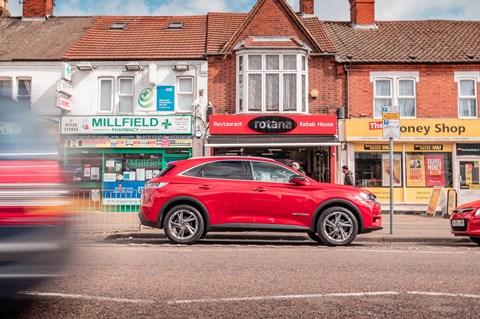
All bar the most basic of DS 7 Crossbacks has a big central touchscreen and big digital instrument screen, with customisable graphics that go big on diamond motifs and have a strong Art Deco/ancient Egypt vibe that would make Hercule Poirot feel right at home.
Mine also has a ludicrous rectangular analogue clock that swivels into view when you turn the engine on. Ludicrous because it has a 4 and an 8 instead of a 3 and a 9, and ludicrous because the central touchscreen has a big digital time display precisely six inches away.
The least striking aspects so far are the normal car things – the engine, the chassis. Our DS uses PSA’s 1.6-litre turbo four in 221bhp form, driving the front wheels through an eight-speed automatic gearbox. It’s not particularly quick or particularly economical. You wouldn’t want one of the less powerful engines. The imminent hybrid might be the answer.
I like it a lot. I like telling people what it is and why it’s not a Citroën, even if my explanation is different every time. If you’re DS-curious, or even a DS owner, and can help me understand what the whole DS thing is all about please get in touch so we can compare notes. Meanwhile, I’ll be keeping a count of how many other DS 7s I see.
By Colin Overland
Logbook: DS 7 Crossback Prestige PureTech 225
Price £39,530 (£40,280 as tested)
Performance 1598cc 4-cyl turbo petrol, 221bhp, 8.3sec 0-62mph, 141mph
Efficiency 36.5mpg (official), 31.2mpg (tested), 136g/km C02
Energy cost 18.2p per mile
Miles this month 1902
Total miles 9597